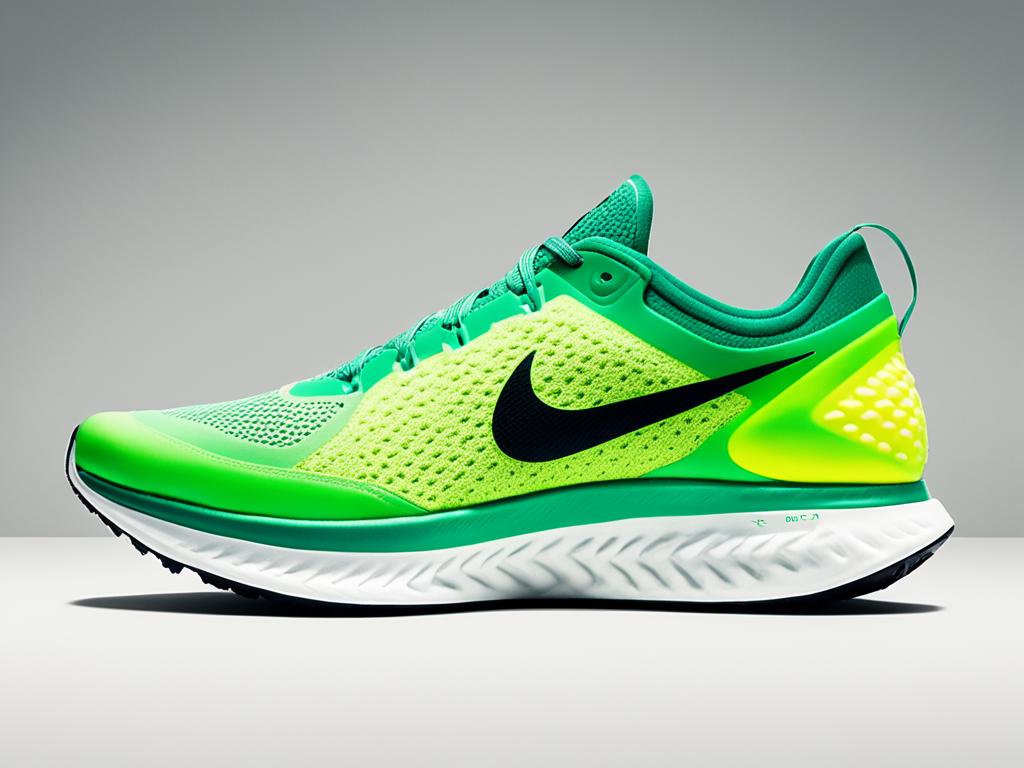Nike is committed to sustainability and has launched its Move to Zero campaign, aiming for zero carbon and zero waste by 2025. They are focusing on carbon, waste, water, and chemistry to protect the future of sport. Nike is reusing existing materials and inventing new ones to reduce their carbon footprint and waste. Their circular solutions involve rethinking product creation, lifespan, and recycling. Nike offers a Product Care guide for maintenance and encourages customers to donate or recycle worn athletic shoes. They also repurpose vintage and dead stock products to create new designs.
Key Takeaways:
- Nike is committed to sustainability and aims for zero carbon and zero waste by 2025.
- They focus on carbon, waste, water, and chemistry to protect the future of sport.
- Nike reuses existing materials and invents new ones to reduce their carbon footprint and waste.
- They offer a Product Care guide and promote shoe donation and recycling.
- Nike repurposes vintage and dead stock products to create new designs.
Nike’s Sustainable Materials
Nike is committed to developing sustainable materials for their products, understanding that the choice of materials has a significant impact on a product’s carbon footprint. In fact, materials account for over 70% of the carbon footprint of Nike products. To address this, Nike has introduced a range of innovative and eco-friendly materials that support their sustainability goals.
Nike Forward: A Game-Changing Material
One of Nike’s newest sustainable materials is Nike Forward. This innovative material is not only super soft, warm, and lightweight, but it also boasts an impressive 75% reduced carbon footprint compared to traditional knit fleece. Nike Forward is a testament to Nike’s commitment to creating sustainable and environmentally conscious sportswear.
Nike Flyknit: Made from Recycled Plastic Bottles
Another sustainable material developed by Nike is Nike Flyknit. This material is created using recycled plastic bottles, helping to reduce waste and promote a circular economy. Nike Flyknit not only offers performance benefits but also contributes to sustainable fashion by utilizing recycled materials.
Nike Flyleather: Combining Recycled and Synthetic Fibers
Nike Flyleather is yet another example of Nike’s dedication to sustainable materials. This unique material is made by combining recycled leather fibers with synthetic fibers. By repurposing and recycling materials, Nike aims to create sustainable alternatives for their customers, providing them with eco-friendly Nike gear.
Through these sustainable material innovations, Nike is pioneering a new era of environmentally conscious sportswear and sustainable Nike sneakers. By making responsible choices in material sourcing and development, Nike is leading the way toward a more sustainable and ethically conscious future in the fashion industry.
Nike’s Circular Solutions
Nike is committed to reducing waste and promoting a circular economy through its innovative initiatives. By implementing circular solutions, Nike aims to minimize environmental impact and offer ethical products that align with the principles of conscious consumerism.
- Encouraging product care: Nike emphasizes the importance of maintaining and caring for their products to prolong their lifespan. By providing customers with proper product care instructions, Nike ensures that their performance wear remains in optimal condition for a longer period of time, reducing the need for frequent replacements.
- Promoting recycling: Nike actively encourages customers to recycle their used products through various recycling initiatives. By participating in these programs, individuals can contribute to minimizing waste and supporting the circular economy.
- Selling refurbished returned shoes: As part of their circular solutions, Nike offers refurbished returned shoes as a sustainable reuse option. By giving these shoes a second life, Nike reduces waste and provides customers with an ethical choice for their footwear needs.
- Repurposing vintage and dead stock products: Nike creatively repurposes vintage and dead stock products to create new designs. This practice not only breathes new life into existing materials but also reduces the demand for new resources, further supporting sustainable and conscious consumerism.
As part of their commitment to sustainability, Nike has set ambitious goals for their circular solutions. By 2025, Nike aims to divert 100% of waste from landfill in their supply chain and recycle at least 80% of waste back into their products. They also strive to reduce greenhouse gas emissions, water usage, and implement environmentally preferred materials in their products. Through these efforts, Nike continues to lead the way in creating sustainable performance wear that meets the needs of conscious consumers.
Nike’s Material Development
When it comes to sustainable performance wear and eco-friendly Nike gear, Nike recognizes that materials play a significant role in reducing environmental impact. In fact, over 70% of the carbon footprint of any Nike product comes from its materials. That’s why Nike is committed to developing sustainable materials that minimize their environmental footprint.
Nike has introduced several innovative materials that prioritize sustainability without compromising performance. One such material is Nike Forward, an all-new fabric that is super soft, warm, and lightweight. Compared to traditional knit fleece, Nike Forward boasts a reduced carbon footprint of 75%, making it an excellent choice for environmentally conscious sportswear.
Another breakthrough material from Nike is Nike Flyknit, which is made from recycled plastic bottles. This eco-friendly material not only reduces waste but also delivers high performance. Nike also developed Nike Flyleather, a material that combines recycled leather fibers with synthetic fibers. By repurposing materials, Nike is able to create sustainable alternatives for their customers, reinforcing their commitment to sustainability.
Voluntary Restrictions and Responsible Sourcing
Nike goes above and beyond by imposing voluntary restrictions on chemicals used in their products. This ensures that their products are not only sustainable but also safe for consumers. Additionally, Nike prioritizes responsible sourcing by using organic and recycled materials, as well as incorporating Better Cotton—an initiative that promotes sustainable cotton farming practices.
The brand also makes use of recycled polyester, which helps to save plastic bottles from the landfill. By opting for recycled polyester in their production processes, Nike significantly reduces their environmental impact while providing eco-friendly Nike gear that meets the demands of sustainable performance wear. This commitment to material development supports Nike’s overall sustainability goals and ensures a better alternative for their customers.

In the next section, we’ll explore Nike’s innovative ReactX foam and how it further reduces the carbon footprint of their shoes, offering sustainable Nike sneakers for conscious consumers.
ReactX Foam: Reducing Carbon Footprint
Nike is continuously innovating to create sustainable solutions, and their ReactX foam is no exception. Designed to reduce the carbon footprint of their shoes, ReactX foam is a cutting-edge material that showcases Nike’s commitment to eco-friendly practices.
Launching soon in the highly anticipated InfinityRN 4, a shoe designed specifically for road running, ReactX foam presents a groundbreaking advancement in sustainable footwear technology. By utilizing this revolutionary material, Nike aims to set new standards for sustainable Nike sneakers.

The carbon footprint of Nike’s midsoles is significantly reduced by over 43% when using ReactX foam, compared to previous compression molding methods. This substantial reduction represents a major step forward in minimizing the environmental impact of shoe production.
But sustainability doesn’t come at the expense of performance. ReactX foam also delivers superior support and cushioning, ensuring that athletes can enjoy both comfort and sustainability in their gear.
Nike’s investment in research and development is evident in the creation of ReactX foam, combining performance-enhancing qualities with an eco-friendly approach. This new material represents Nike’s dedication to providing customers with sustainable and high-quality products.
Nike’s Sustainability Targets
Nike has made a significant commitment to reducing its environmental impact through its sustainability targets. The company is focused on various areas of its business to achieve these goals and become a more sustainable and ethical brand.
One of Nike’s key targets is to reduce greenhouse gas emissions, minimizing its contribution to climate change. They also aim to increase the use of environmentally preferred materials in their products, ensuring that their athletic wear is both sustainable and high-performing.
In addition, Nike is actively working to divert waste from landfills and reduce its fresh water usage in textile dyeing processes. By implementing innovative circular design practices and encouraging product care, recycling, and repurposing, Nike strives to create a closed-loop system that minimizes waste and maximizes resource efficiency.
To further minimize its environmental impact, Nike is also dedicated to reducing greenhouse gas emissions in its owned or operated facilities. By implementing energy-saving measures and adopting renewable energy sources, Nike aims to create a more sustainable and eco-friendly supply chain.
FAQ
What is Nike’s commitment to sustainability?
Nike is committed to sustainability and has launched its Move to Zero campaign, aiming for zero carbon and zero waste by 2025. They are focusing on carbon, waste, water, and chemistry to protect the future of sport.
How is Nike reducing their carbon footprint and waste?
Nike is reusing existing materials and inventing new ones to reduce their carbon footprint and waste. Their circular solutions involve rethinking product creation, lifespan, and recycling. They also repurpose vintage and dead stock products to create new designs.
What does Nike offer in terms of product care and recycling?
Nike offers a Product Care guide for maintenance and encourages customers to donate or recycle worn athletic shoes. They also repurpose vintage and dead stock products to create new designs.
What sustainable materials has Nike developed?
Nike continuously develops sustainable materials to minimize their environmental impact. They have introduced Nike Forward, Nike Flyknit, and Nike Flyleather as innovative materials with reduced carbon footprints.
How is Nike promoting a circular economy?
Nike’s circular solutions involve various initiatives to reduce waste and promote a circular economy. They encourage product care for longer life, promote recycling of used products, sell refurbished returned shoes as a sustainable reuse option, and repurpose vintage and dead stock products.
What is ReactX foam and how does it reduce carbon footprint?
ReactX foam is a new sustainable material developed by Nike. It reduces the carbon footprint of Nike shoes, specifically the midsole, by over 43% compared to previous compression molding methods. It offers improved support and cushioning for users.
What are Nike’s sustainability targets?
Nike has set ambitious sustainability targets to reduce their environmental impact. They aim to reduce greenhouse gas emissions, increase the use of environmentally preferred materials, divert waste from landfills, and reduce fresh water usage in their textile dyeing processes.

Leave a Reply